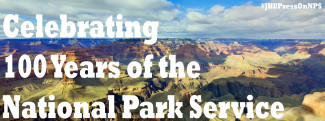
Johns Hopkins UniversityEst. 1876
America’s First Research University
The C&O Canal & the Historic Potomac Landscape

The National Park Service (NPS) celebrates its centennial anniversary in the month of August! NPS has served as a valuable resource for many of our authors, both professionally and recreationally. To commemorate the occasion, our authors have taken to the blog to pay homage to “America’s best idea”! Check back with us throughout the month of August for more #JHUPressOnNPS! (Series photo credit: Wikimedia)

As a resident of Northern Virginia, I spend a lot of time hiking, biking, and kayaking along the Potomac, taking advantage of the C&O National Park and its neighbors, such as the national parks at Harpers Ferry and Great Falls, Virginia.
In the early 1990s, I started leading a regular four-day tour up the C&O Canal (184 miles) for the local bike club, and began putting together informational notes for the rides. These notes grew bigger and bigger as I added details about trader cabins, frontier settlements, Civil War river crossings, and the general history of mills, ironworks, canals, railroads, and, eventually, hydroelectric dams that sprang up along the Potomac.
At some point, one of my fellow-riders suggested that the packet had the makings of a book. I didn’t pay much attention at first, but over the course of four days, he was able to plant the seeds that became the C&O Companion, first published in 1997.
The book project was a great excuse to get outdoors on a regular basis. Almost every weekend, summer through winter, I’d be somewhere on the trail, in the water, or scrambling up rock faces along the Potomac. Sometimes it was a bike ride through snow where the canal cuts through the mountain ridges at Paw Paw, sometimes it was a leisurely stroll to find the stonecutting mill, which produced the distinctive red sandstone for the Smithsonian “castle” building. I waded across the Potomac at some of the old Civil War fords, just to make sure it could be done.
Once I nearly lost a couple of friends—literally and figuratively—crisscrossing through gullies and cliffs to find the old marble quarry that produced the stone columns for the House of Representatives chamber in the U.S. Capitol.
The project was also an excuse to dig through the archives—not only the canal company records kept at the National Archives, but the detailed historical reports and structural studies prepared by the National Park Service. These were kept in a small office next to the Ferry Hill mansion overlooking the river at Shepherdstown, which is always a delightful excursion in itself.
I returned to this research when I put together the expanded second edition (published in 2015). I was encouraged and sometimes amazed to see the many ways that the Park had been developed, with permanent pedestrian bridges erected where flimsy structures had been washed away by the 1996 floods, and the Monocacy and Catoctin Aqueducts restored to their original elegance.
For all of the history worked into this landscape, the greatest treasure preserved by the parks is the riparian corridor that leads all the way from the nation’s capital into the Appalachian mountains. The C&O canal, almost obsolete by the time it was completed, managed to operate for 74 years, keeping the Maryland side of the river open for public use.
The canal park, in turn, has helped inspire other notable preservation efforts, including a system of foot trails on the Virginia side of the river, and, dramatically, the GAP rail-trail across the mountains to Pittsburgh. The combination of the canal and the rail-trail is, as I point out in my book, the same historic route that George Washington used during the French and Indian wars—a 330-mile greenway that has no equal anywhere in the United States.
Mike High holds degrees in English and creative writing from the University of Virginia. His work has appeared in "Poets & Writers" and the "Los Angeles Times," among other publications. He has cycled in many places around the world, but the trail along the C&O Canal remains his favorite ride. The second edition of his book, The C&O Canal Companion: A Journey through Potomac History, is available now.

